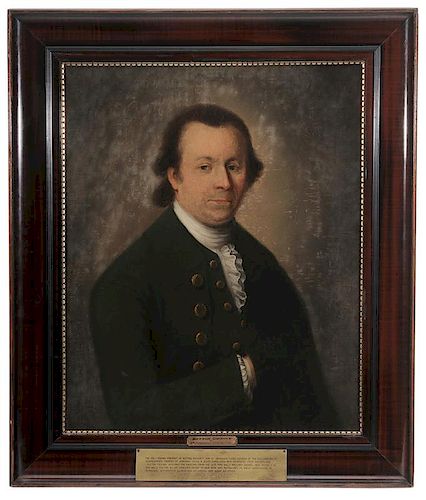Georgia Colonial Portrait
Bid Increments
| Price | Bid Increment |
|---|---|
| $0 | $25 |
| $100 | $50 |
| $1,000 | $100 |
| $2,000 | $200 |
| $3,000 | $250 |
| $5,000 | $500 |
| $10,000 | $1,000 |
| $20,000 | $2,000 |
| $50,000 | $5,000 |
| $100,000 | $10,000 |
(18th century) A famous and storied portrait of Button Gwinnett, signer of the Declaration of Independence for the state of Georgia, signed verso "Theus/ Charle…" and inscribed with sitter's name, thought to be by Jeremiah Theus (Charleston, South Carolina/Swiss, 1719-1774), oil on canvas, 30 x 23-3/4 in.; grain painted wood frame, with placard stating provenance inscription and signature slightly obscured and viewed through window in linen lining with beeswax, patch at "Charleston" inscription, face and background with heavy retouch, face with extensive restoration, crackle, likely original pine strainer. Notes: In the mid 20th century all of Savannah seemed to have an opinion about the portrait of Button Gwinnet hanging proudly in the Fulton Federal Savings and Loan building.. Provenance: With Hirschl and Adler, purchased by Fulton Federal Savings & Loan Association in 1958 then to Sarah Belle Brodnax Hansell, Mimosa Hall, Roswell, Georgia; Charles Edward Brodnax Hansell and Sylvia Hansell, Mimosa Hall, Roswell, Georgia;
Literature:
Illustrated William , Roger M., “Who Got Button’s Bones?”, American Heritage, February 1966, Volume XVII, Number 2, page 30 (accompanied by book); Jackson, Edwin L., The Georgia Studies Book, The Carl Vinson Institute of Government, The University of Georgia, illustrated, 2004
Exhibitions:
The High Museum of Art: Letter, to Robert Watson, Fulton County Federal Savings and Loan from Gudmund Vigtel, Director, High Museum of Art, letters regarding loan and donation interest, dated March 21, 1983. The portrait was to be exhibited for the period of 3 years commencing August 12, 1983, insured for $40,000. The Georgia Museum of Art: Georgia’s Legacy: History Charted Through the Arts, 1986/86; Copy of Letter of sale offer from C. Edward Hansell, Mimosa Hall, to Fulton County Federal Savings and Loan, dated November 5, 1985, for $50,000; Letter, Hirschl and Adler, dated Dec.5, 1957, (facsimile), The gallery conferred on authenticity with Mr. Harold Milch, Milch Galleries; Letter, Milch Galleries, dated Dec. 2, 1957Harold Milch authenticates the portrait as Jeremiah Theus, based on his experience with mant Theus portraits, (facsimile); Letter, Hirschl & Adler, dated Feb. 25, 1966 provenance; Letter of Authentication/ guarantee, Hirschl & Adler , dated April 25, 1957, signed by Norman Hirschl (facsimile); Western Union Telegrams (facsimiles) September 5, 1958, Arthur Funk to Dr. Reginald Poland, calls into question the identity of the sitter and the authorship of Theus. Portrait did not appear in the sale of Button Gwinnett’s belongings in 1777-78.; Newspaper article (facsimile) dated September 15, 1958 “Prof. Sheldon Keck of the Brooklyn Musem, an authority on American art and technique, subjected the picture to a microscopic and ultraviolet examination. He pronounced the portrait mid-18th century work, the ink of the inscription genuine ink of two centuries ago. Dr. Robert G. McIntyre, former director of the MacBeth Galleries, currently advisor to many museums, examined the portrait and adjudged it unquestionably an example of Jeremiah Theus, and much like the verified Theus portrait of Daniel Ravenel.; Letter, law firm for Fulton County Federal Savings and Loan to Arthur Funk, dated September 12, 1953, (facsimile) Assuring the research was based on “several months and it was not purchased until after what were regarded as competent authorities had indicated the genuineness.”; Letter, from the above, signed by purchaser Granger Hansell to Theus expert Mrs. Margaret Simons Middleton, dated Sept. 12, 1958 (facsimile) states,” X-rays did not disclose anything under it.”; Partial letter, Library of Congress, Reference Department, (facsimile) dated May 8, 1957, stating that, stating, “there is no known authentic likeness of Button Gwinnett, nor is it likely any portrait of him was ever painted.”; Letter, law firm, from Granger Hansell, (facsimile), dated August 1, 1963 granting permission to reproduce the portrait in a book by Mrs. Herbert J. Sanborn, Alexandria, Virginia.
Various other news articles and correspondence:
Article (facsimile),dated September 17, 1958 and titled “Button Gwinnett Portrait Causes More News Stories Than His Death In Duel More Than 181 Years Ago.”; Brochure about the portrait produced by Fulton County Federal Savings and Loan (facsimile); Letter to Arthur Funk form Fulton County Federal Savings and Loan signed Granger Hansell (facsimile) and dated September 19, 1958 stating, “..The Association also had correspondence with Mrs Middleton. She said that she had heard about the existence of this portrait but that the owner of it seemed to be so indifferent she did not pursue it any further.”; Newspaper article (facsilie) titled, “Real or Spurious, Gwinnett Portrait To Be Shown Today”; Newspaper Article (facsimile), titled “Painting of Button Gwinnett Authenticated by Art Group”; Newspaper article (facsimile) dated 1/20/2001 stating a portrait said to be Button Gwinnet sells for $115,750 by Sotheby’s; Letter, to Robert Watson, Fulton County Federal Savings and Loan from Gudmund Vigtel, Director, High Museum of Art, letters regarding loan and donation interest, dated March 21, 1983. The portrait was to be exhibited for the period of 3 years commencing August 12, 1983, insured for $40,000.
Condition
inscription and signature slightly obscured and viewed through window in linen lining with beeswax, patch at "Charleston" inscription, face and background with heavy retouch, face with extensive restoration, crackle, likely original pine strainer
Purchaser agrees that packing and shipping is done at the purchaser’s risk and that the purchaser will pay in advance all packing expenses, materials, carrier fees and insurance charges. At our discretion, items will either be packed by an agent such as a packaging store or Brunk Auctions. Please allow two weeks for shipping after payment is received. Shipment of large items is the responsibility of the purchaser. We are happy to provide names of carriers and shippers if a purchaser so requests. Brunk Auctions will have no liability for any loss or damage to shipped items.










